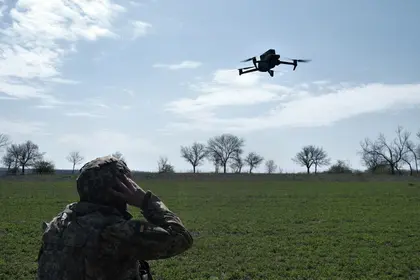Responding to requests from Kyiv, the Polish government has eased the process of exporting military-use drones to Ukraine by allowing exporters to group multiple shipments under a single general permit, rather than requiring individual permission for each.
The new policy went into effect on April 28.
JOIN US ON TELEGRAM
Follow our coverage of the war on the @Kyivpost_official.
Crippling delays in the delivery of unmanned aerial vehicles (UAVs) to Ukraine began to be noticed in the fall of 2022, launching petitions from Kyiv to the Polish Ministry of Economic Development and Technology to cut through some of the red tape requiring each drone producer and distributor from filing individual export documentation.
- View the most up-to-date Ukraine news articles published today.
- Read the newest Ukraine news stories published today.
"Today, we have the results of our work,” said Ukraine’s Deputy Economy Minister and trade representative Taras Kachka. “The decision of the Polish government will help accelerate the supply of UAVs to the front lines, strengthen Ukraine's defense capabilities and accelerate the victory over the aggressor."
The move potentially could save thousands of Ukrainian lives, said Maria Berlinska, a military volunteer and founder of the Ukrainian Center for Aerial Reconnaissance, and a longtime proponent of the export-streamlining initiative.
Berlinska, once a military drone operator herself, said that she first encountered the problem in September, when she ordered more than 500 DJI Mavic 3 Drones, which had to go through Poland, as usual, but the cargo was held-up at the border as a "dual-use commodity.” Subsequently, it turned out that other volunteers faced the same problem, she said. She estimated that the total cost of cargo stuck in Poland was in the millions of U.S. dollars.

Trump’s Russia Plan – Will It Work? NATO, Putin & US Strategy Explained
"That resulted in thousands of deaths within our military. Together with our commander, we calculated that one drone saves more than 50 people, and sometimes an entire company,” Berlinska said.
"In informal conversations, the Poles told us that in fact it was the Ukrainian state export control service (DSEC) that considered these drones to be dual-use goods. It turns out that even the simplest daytime drone without a thermal imaging camera, which, unfortunately, supports the entire forward line, was identified by the DSEC as a dual-use product," Berlinska said in an interview last month with ISLND TV.
"I asked the head of the DSEC, Oleksandr Pavlichenko, dozens of times to stop recognizing these as dual-use goods. But the DSEC misled us for some time, saying that these are the requirements of Western partners to control imports. So after I had exhausted all avenues of direct communication, I had to write an article about it in Ukrainska Pravda," Berlinska said.
After her story was published, the DSEC eventually stopped considering drones as dual-use goods, and some other related products were removed from their control. Subsequently, the Ukrainian government appealed to Polish authorities to ease the restrictions.
Still, Berlinska stressed, Ukraine does not have the capability to produce its own drone parts: Optics, antennas, chips and all avionics equipment have to be purchased from abroad. This process takes about two months, she said.
According to a study by the Air Intelligence Support Center, the largest use of unmanned aerial vehicles in the history of mankind was recorded during the Russian invasion of Ukraine. In December 2022, Russian President Vladimir Putin announced in an address to his military leadership that 2023 will be the year of unmanned technologies.
"In Russia, the best engineers are being driven into cities, Stalin-style, to produce both attack and reconnaissance drones. Those engineers, in turn, give lists of necessary components that are then imported by trucks from China. Drones are immediately tested at the front. The most successful models are put into production in batches," Berlinska said at a conference on March 25.
Now, she contends, every Russian military platoon with 10-20 people has tactical-level drones.
"And we don't have such equipment, and this is why we have these kinds of losses… At this rate, we will no longer have a military, because there are at least five times as many Russian fighters as Ukrainians. So we need attack drones. This is even mathematically cheaper than the same projectiles for HIMARS rocket launchers. Because a drone for a thousand dollars can disable equipment worth millions of dollars," Berlinska said.
“To be truly effective, ten drone raids aren't enough, you need at least one hundred,” said UAV manufacturer Yuri Kasyanov in an interview with HB Radio on February 28. “And we can make them. As a manufacturer, I can say that [in order to build them] I need two thousand square meters in a protected place and about one hundred specialists."
To do this, according to Berlinska, who is also the co-founder of the Victory Drones project, the Ministry of Defense should purchase tactical-level drones for military headquarters. At the moment, she said, drones are bought only by volunteers and organizations such as United24, led by Mykhailo Fedorov.
"We need to give engineers the opportunity to work, and get rid of the incomprehensible inspections and tax burdens, and so on,” she summed up. “We need to give a boost to this industry. People at the front lines are now buying time for us at the cost of their health and lives, so that we can prepare and do what we didn't have time to do before."
You can also highlight the text and press Ctrl + Enter










